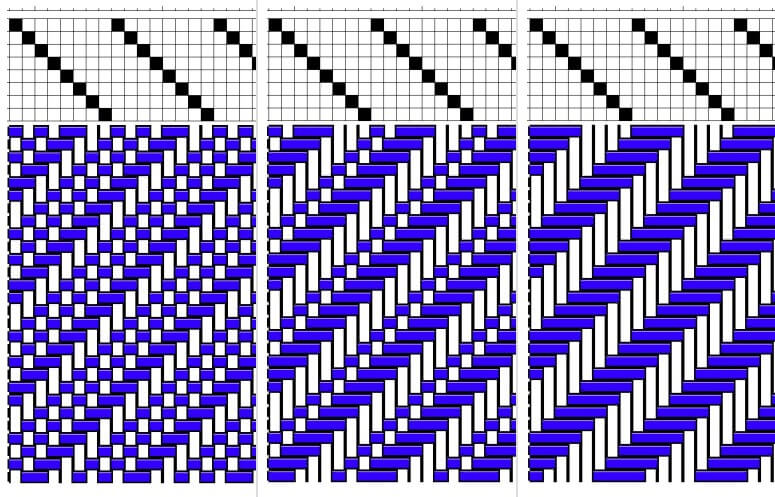As you probably know, sett is critical to getting your project right: if it’s too open, the weft beats in too much and covers the warp. If it’s too close, the fabric can wind up stiff and unsuitable for its purpose.
When working with a new yarn or a new structure, we usually make a reasonable guess at a starting sett, dress the loom, and hope for the best. If our guess is bang on, great! If our guess is WAY off, there’s not really any choice but to resley, but what about when the guess is really close but still somehow not quite right? What are your options then?
Things you can do to fix an almost-working sett
If your sett is close to right but not quite there, you’ve got some options short of resleying. You can’t change the warp sett without resleying, but you CAN change the weft sett – that is, weft picks per inch or cm. Similarly, you can’t change the warp yarns without chucking the whole project and starting over, but you can change the weft yarns.
If the fabric is sleazier than you want it, you can:
- Resley at a closer sett (the hard option)
- Change to a thicker weft yarn (not too bad)
- Beat at more picks than ends per in – motifs will be shortened warpwise (requires attention)
- Change to a tie-up with more interlacement (pretty easily done)
If the fabric is denser than you want it, you can:
- Resley at a wider sett (the hard option)
- Change to a thinner weft yarn (not too bad)
- Beat at fewer picks than ends per inch – motifs will be elongated warpwise (requires attention)
- Change to a tie up with less interlacement (pretty easy to do)
A few things to consider about the above options:
Getting more (or fewer) picks than ends per inch/cm will change the shape of any motifs in the pattern. With fewer picks per inch/cm, diamonds, zigzags, and other motifs will get taller. With more picks per inch/cm, they’ll get shorter. This may or may not be acceptable to you – it depends what YOU want the fabric to look like. It will also affect how much you see the warp. Fewer picks per inch/cm = more warp visible. More picks per inch/cm = less warp visible.
Managing the hand of the fabric by changing the grist (thickness) of the weft yarn is a great option if you happen to have a yarn that is the correct size, colour, and fibre on hand. Keep an open mind as to what constitutes “the correct size, color, and fiber” as well – there might be something in your stash that will give you great results even if it’s not what you’d originally planned to use. This can also affect how much warp you see: assuming the number of picks per inch stays the same, thinner weft = more warp visible and thicker weft = less warp visible.
Changing your beat to pack in more (or fewer) weft ends per inch can also achieve the desired result but most weavers have a “default” beat and it can be tricky to convince your autopilot to do things differently. Instead, beat like normal and change the tension on the loom to adjust how much your default beat packs in. More tension = fewer picks per inch. Less tension = more picks per inch.
Managing twill sett with tie-up
Resleying, changing the weft size, and adjusting your beat are all things you can do regardless of the structure of your fabric. There’s an additional trick you can use in the specific case of twills.
Consider the following drawdowns:

All three of these are twills with the same threading, the same warp, the same weft yarn and the same treadling. The only way they differ is in the amount of interlacement in the tie-up. The one on the left has the most interlacement: the fabric is actually about half plain weave. The one on the right has the least interlacement: all the floats are 4 ends or picks long in both directions. The one in the center is somewhere in between the two.
The more interlacement a structure has, the more space is needed to allow the threads to move from the top surface of the fabric to the bottom. The less interlacement, the less space is needed.
The upshot is this:
- If your twill fabric is a little too sleazy, you can firm it up by changing to a tie-up that has more interlacement
- If your twill fabric is a little too firm, you can add more drape by changing to a tie-up that has less interlacement.
Of course, changing the tie-up also changes the appearance of your fabric, as the drawdowns above demonstrate. In particular, it affects how much warp and weft appear on each side of the fabric, and also how the warp and weft colours mix optically. (You can learn more about optical mixing in this blog post). When it comes to trading off the drape of a fabric vs. the visibility of the design, only you can decide which is more important.
So, if your sett isn’t quite right but isn’t too far off either, you have several ways to change the hand of your fabric without having to resley your warp!

From the Course Catalog:

The Secrets of Liftplans, Treadling, and Tie-Ups – A deep dive into understanding these basics of weaving

Designing in the Tie-Up: Cookies and Clocks – This class shows you how to achieve any design you can doodle in the tie-up.
